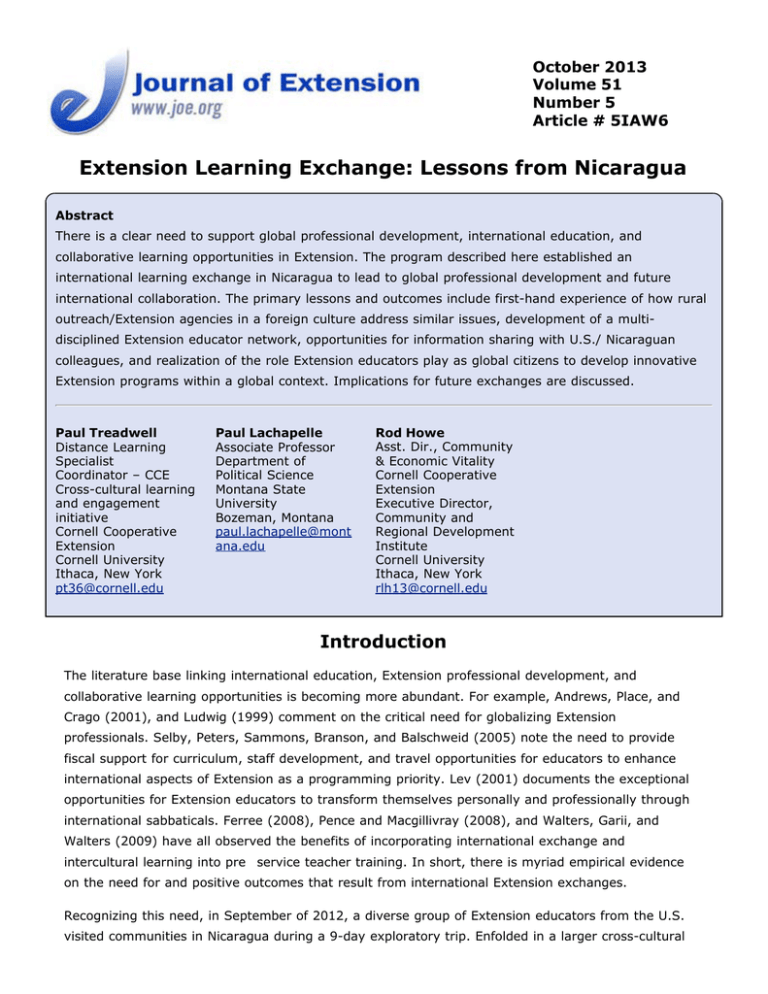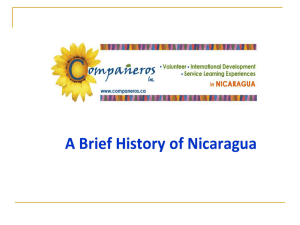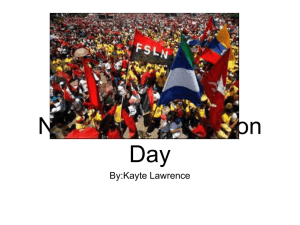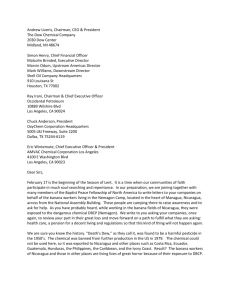Extension Learning Exchange: Lessons from Nicaragua October 2013 Volume 51 Number 5
advertisement

October 2013 Volume 51 Number 5 Article # 5IAW6 Extension Learning Exchange: Lessons from Nicaragua Abstract There is a clear need to support global professional development, international education, and collaborative learning opportunities in Extension. The program described here established an international learning exchange in Nicaragua to lead to global professional development and future international collaboration. The primary lessons and outcomes include first-hand experience of how rural outreach/Extension agencies in a foreign culture address similar issues, development of a multidisciplined Extension educator network, opportunities for information sharing with U.S./ Nicaraguan colleagues, and realization of the role Extension educators play as global citizens to develop innovative Extension programs within a global context. Implications for future exchanges are discussed. Paul Treadwell Distance Learning Specialist Coordinator – CCE Cross-cultural learning and engagement initiative Cornell Cooperative Extension Cornell University Ithaca, New York pt36@cornell.edu Paul Lachapelle Associate Professor Department of Political Science Montana State University Bozeman, Montana paul.lachapelle@mont ana.edu Rod Howe Asst. Dir., Community & Economic Vitality Cornell Cooperative Extension Executive Director, Community and Regional Development Institute Cornell University Ithaca, New York rlh13@cornell.edu Introduction The literature base linking international education, Extension professional development, and collaborative learning opportunities is becoming more abundant. For example, Andrews, Place, and Crago (2001), and Ludwig (1999) comment on the critical need for globalizing Extension professionals. Selby, Peters, Sammons, Branson, and Balschweid (2005) note the need to provide fiscal support for curriculum, staff development, and travel opportunities for educators to enhance international aspects of Extension as a programming priority. Lev (2001) documents the exceptional opportunities for Extension educators to transform themselves personally and professionally through international sabbaticals. Ferree (2008), Pence and Macgillivray (2008), and Walters, Garii, and Walters (2009) have all observed the benefits of incorporating international exchange and intercultural learning into pre service teacher training. In short, there is myriad empirical evidence on the need for and positive outcomes that result from international Extension exchanges. Recognizing this need, in September of 2012, a diverse group of Extension educators from the U.S. visited communities in Nicaragua during a 9-day exploratory trip. Enfolded in a larger cross-cultural October 2013 Extension Learning Exchange: Lessons from Nicaragua JOE 51(5) learning initiative originating at Cornell Cooperative Extension, this initial "learning exchange" to Nicaragua was intended to build a foundation for future growth and collaboration. Trip participants were drawn from the fields of community development, agriculture, and youth development. This diversity in participants created a fertile cross-discipline team that engaged with participants in Nicaragua across disciplinary boundaries. Program Goals The primary goal of the program was to engage in an international learning exchange that would lead to global professional development and learning and future international collaboration. Specifically, the group sought to develop collaborative relationships and subsequent opportunities that would create a foundation for future professional interaction. To accomplish the goals, the groups sought to: 1. Engage with colleagues (faculty and students) from National Autonomous University of Nicaragua, 2. Visit cooperatives and other non-governmental organizations, 3. Explore small-scale development opportunities, 4. Discuss and share personal and professional expectations and outcomes regarding learning in a global context Nicaragua was chosen for several reasons; 1. There are active connections to non-profits working in Nicaragua through Cornell University, 2. There is a strong connection to the National University of Nicaragua, and 3. As a result, there is relative ease of access and low cost of travel from the United States. Program Highlights The trip began with 3 days in San Ramon, a small community in the heart of the coffee-producing region approximately 3 hours from the capital Managua, with the group participating in a homestay experience. This was a deliberate choice to allow the group to experience daily life in a rural community. Living with a family for even 3 days exposed participants to the richness and diversity of life that is otherwise hidden to the visitor. Among the visits were a coffee cooperative, several small women's economic development projects, a local youth development program, and the local cooperative of cooperatives. A unique example of local outreach and education work included a visit to the Union of Farming Cooperatives (UCA ). The UCA is a regional cooperative of cooperatives that has a member base that includes coffee, honey, milk, and other agricultural producers. The UCA is also engaged in educating its member constituents about violence against women by using a popular educational theater performance method effective for conveying information when literacy is low. The group next traveled to Leon in the northwest to meet with faculty and staff from The National Autonomous University of Nicaragua (UNAN Leon) around issues of community development and ©2013 Extension Journal Inc. 2 October 2013 Extension Learning Exchange: Lessons from Nicaragua JOE 51(5) agriculture, with related tours of the agroecology and veterinary sciences facilities, an iguana nursery, a women's economic development project, and a sustainable farming project . Several research labs were featured on the campus tour, including entomology and plant diagnostic labs. Viewing the limited equipment helped participants realize the challenges of linking research to community outreach in the second poorest country in the hemisphere. The researchers and faculty demonstrated that results were having a direct and positive impact in Nicaragua and other Latin American countries, showing the relevance of research to practical applications. Also associated with the university was a women's economic development project spread across several nearby rural communities. Working with university faculty and students, this project is being facilitated by UNAN Leon, but is firmly rooted in the realities and needs of the individual communities. Through the assistance of the university, small-scale, often micro, enterprises are being explored by the women as means of increasing income, which will lead to increased food security and health. The trip concluded with 2 days in Granada, a community in western Nicaragua. After the intense activity of the preceding week, time in Granada was intentionally less structured in order to provide openings for reflection. Conclusions and Lessons Learned While there are many outcomes from the program, below is a list of seven primary lessons taken from this effort. 1. Extension work can arise from a diversity of groups working within a community, including groups and organizations that have no formal designation as extension, but are doing Extension work. 2. Global exchanges offer first-hand understanding of how rural outreach/Extension agencies in a foreign culture address similar issues. 3. Youth education and community development opportunities abound in international settings, with tremendous potential for two-way exchanges and information sharing. 4. Global exchanges can help develop a multi-disciplined Extension educator network. 5. Exchanges can provide career-long opportunities for information sharing with international colleagues. 6. Global training enhances language skills, the ability to deal with diversity, communicating messages succinctly to new audiences, team-building, as well as providing hope and conviction that it is possible to change the world. 7. Exchanges can enhance Extension's ability to make informed decisions that link the local to the global and strengthen youth, families, and communities; sustain natural resources; and improve the economy. ©2013 Extension Journal Inc. 3 October 2013 Extension Learning Exchange: Lessons from Nicaragua JOE 51(5) Based on these lessons, future trips are now being planned that will include Extension professionals, faculty, and university students who will engage in short-term research projects. Longer-term collaborations and projects are also being explored. For more information, please contact the first author. References Andrews, M. P., Place, N. T., & Crago, N. E. (2001). A globally focused Extension service. In F.L. Brewer (Ed.), Agricultural Extension systems: An international perspective (pp. 125-151). North Chelmsford, Massachusetts: Erudition Books. Ferree, R. (2008). International Extension…What are the local benefits? PAD 651 final paper. University of Illinois. Lev, L. (2001). Leave home! International sabbaticals as unfreezing experiences. Journal of Extension [On-line], 39(4). Article 4COM1. Available at: http://www.joe.org/joe/2001august/comm1.php Ludwig, B. G. (1999). Globalizing Extension professionals. Journal of Extension [On-line], 37(4). Article 4RIB5. Available at: http://www.joe.org/joe/1999august/rb5.php Pence, H. M., & Macgillivray, I. K.. (2008). The impact of an international field experience on preservice teachers. Teaching and Teacher Education . 24(1):14–25. Retrieved from: http://linkinghub.elsevier.com/retrieve/pii/S0742051X07000042 Selby, K.A., Peters, J. L., Sammons, D. J., Branson, F. F. , & Balschweid, M. A. (2005). Preparing Extension educators for a global community, Journal of Extension [On-line], 43(4) Article 4RIB1. Available at: http://www.joe.org/joe/2005august/rb1.php Walters, L. M., Garii, B., & Walters, T. (2009). Learning globally, teaching locally: Incorporating international exchange and intercultural learning into pre service teacher training. Intercultural Education 20(1): 151–158. Available at: http://dx.doi.org/10.1080/14675980903371050 Copyright © by Extension Journal, Inc. ISSN 1077-5315. Articles appearing in the Journal become the property of the Journal. Single copies of articles may be reproduced in electronic or print form for use in educational or training activities. Inclusion of articles in other publications, electronic sources, or systematic large-scale distribution may be done only with prior electronic or written permission of the Journal Editorial Office , joe-ed@joe.org. If you have difficulties viewing or printing this page, please contact JOE Technical Support ©2013 Extension Journal Inc. 4




